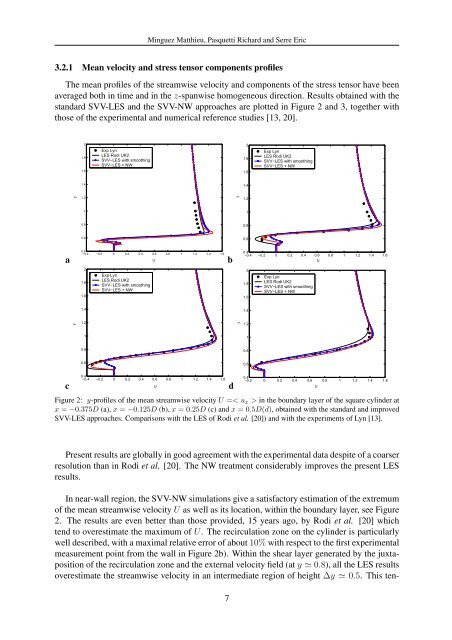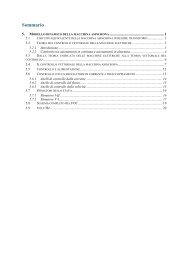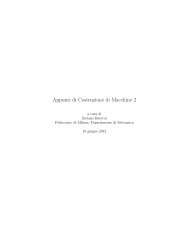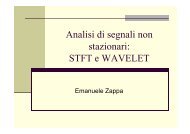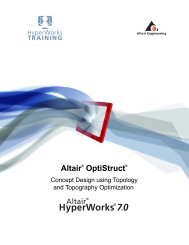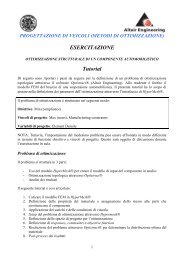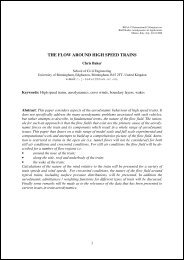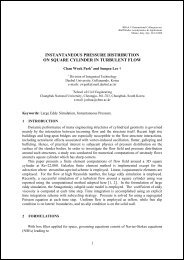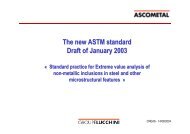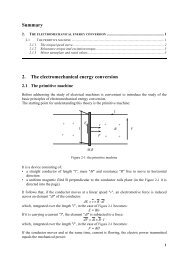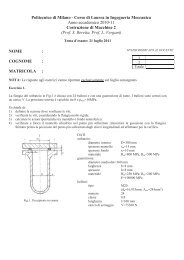spectral les of turbulent flows over bluff bodies: from the ... - BBAA VI
spectral les of turbulent flows over bluff bodies: from the ... - BBAA VI
spectral les of turbulent flows over bluff bodies: from the ... - BBAA VI
Create successful ePaper yourself
Turn your PDF publications into a flip-book with our unique Google optimized e-Paper software.
Minguez Matthieu, Pasquetti Richard and Serre Eric3.2.1 Mean velocity and stress tensor components pr<strong>of</strong>i<strong>les</strong>The mean pr<strong>of</strong>i<strong>les</strong> <strong>of</strong> <strong>the</strong> streamwise velocity and components <strong>of</strong> <strong>the</strong> stress tensor have beenaveraged both in time and in <strong>the</strong> z-spanwise homogeneous direction. Results obtained with <strong>the</strong>standard SVV-LES and <strong>the</strong> SVV-NW approaches are plotted in Figure 2 and 3, toge<strong>the</strong>r withthose <strong>of</strong> <strong>the</strong> experimental and numerical reference studies [13, 20].21.81.6Exp LynLES Rodi UK2SVV−LES with smoothingSVV−LES + NW21.81.6Exp LynLES Rodi UK2SVV−LES with smoothingSVV−LES + NW1.41.4y1.2y1.2110.80.80.60.6a0.4−0.4 −0.2 0 0.2 0.4 0.6 0.8 1 1.2 1.4 1.6Ub0.4−0.4 −0.2 0 0.2 0.4 0.6 0.8 1 1.2 1.4 1.6U21.81.6Exp LynLES Rodi UK2SVV−LES with smoothingSVV−LES + NW21.81.6Exp LynLES Rodi UK2SVV−LES with smoothingSVV−LES + NW1.41.4y1.2y1.2110.80.80.60.6c0.4−0.4 −0.2 0 0.2 0.4 0.6 0.8 1 1.2 1.4 1.6Ud0.4−0.2 0 0.2 0.4 0.6 0.8 1 1.2 1.4 1.6UFigure 2: y-pr<strong>of</strong>i<strong>les</strong> <strong>of</strong> <strong>the</strong> mean streamwise velocity U =< u x > in <strong>the</strong> boundary layer <strong>of</strong> <strong>the</strong> square cylinder atx = −0.375D (a), x = −0.125D (b), x = 0.25D (c) and x = 0.5D(d), obtained with <strong>the</strong> standard and improvedSVV-LES approaches. Comparisons with <strong>the</strong> LES <strong>of</strong> Rodi et al. [20]) and with <strong>the</strong> experiments <strong>of</strong> Lyn [13].Present results are globally in good agreement with <strong>the</strong> experimental data despite <strong>of</strong> a coarserresolution than in Rodi et al. [20]. The NW treatment considerably improves <strong>the</strong> present LESresults.In near-wall region, <strong>the</strong> SVV-NW simulations give a satisfactory estimation <strong>of</strong> <strong>the</strong> extremum<strong>of</strong> <strong>the</strong> mean streamwise velocity U as well as its location, within <strong>the</strong> boundary layer, see Figure2. The results are even better than those provided, 15 years ago, by Rodi et al. [20] whichtend to <strong>over</strong>estimate <strong>the</strong> maximum <strong>of</strong> U. The recirculation zone on <strong>the</strong> cylinder is particularlywell described, with a maximal relative error <strong>of</strong> about 10% with respect to <strong>the</strong> first experimentalmeasurement point <strong>from</strong> <strong>the</strong> wall in Figure 2b). Within <strong>the</strong> shear layer generated by <strong>the</strong> juxtaposition<strong>of</strong> <strong>the</strong> recirculation zone and <strong>the</strong> external velocity field (at y ≃ 0.8), all <strong>the</strong> LES results<strong>over</strong>estimate <strong>the</strong> streamwise velocity in an intermediate region <strong>of</strong> height ∆y ≃ 0.5. This ten-7


